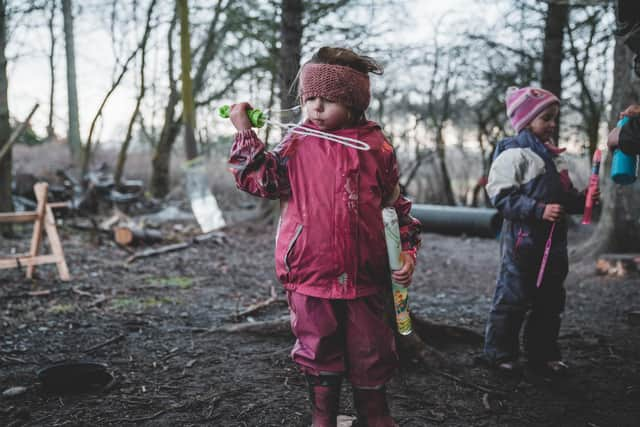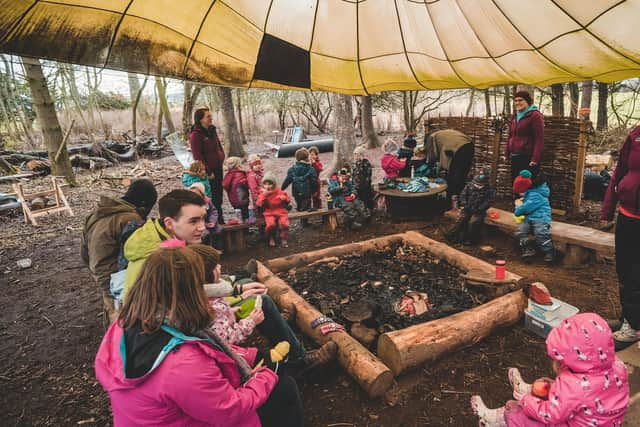'Why are kids learning inside?': How the Covid pandemic could take education outdoors in Scotland for good
When pilot outdoor nursery scheme ‘The Welly Wanderers’ was launched by the Jeely Piece Club charity in 2017, most of the outcomes in children were as anticipated – better sleeping patterns, higher levels of wellbeing and improved physical health.
One of the unexpected perks, however, emerged at lunchtimes, when ordinarily fussy children took to food they would never usually touch.
Advertisement
Hide AdAdvertisement
Hide Ad“We found that children were actually trying more new foods outdoors because they were hungrier – they tried things they never would have otherwise like hot chocolate, hot soups”, explains Elaine McKenna, head of the early years’ service at the Glasgow-based charity.


It is just one example, says Ms McKenna, of the benefits that come with taking education out into the open, with the Welly Wanderer pilot itself so successful that it led to a permanent early years centre, The Jeely Piece Club Nursery, opened in Glasgow’s Castlemilk area in 2019.
The Jeely Piece Club Nursery is by no means an outlier. Rachel Cowper, from charity Inspiring Scotland, estimates “outdoor nurseries in Scotland have doubled in just a handful of years, from 18 to around 36 or 40”.
In spite of this shift, outdoor education has long been viewed in some circles as niche or applicable to certain kinds of learning – like physical education – only.
In 2020, however, when indoor activities were rendered much higher risk than those taken outside, outdoor learning suddenly found itself on the agenda, with educators turning to school grounds and local parks as Covid-safe learning settings.Far from being unprompted, this shift to outdoor learning during the pandemic was encouraged by the Scottish Government, which pledged £1 million to a nursery-age winter clothing fund in December to maximise time outdoors and thus minimise viral risk among children and staff.


The Scottish Government, in fact, has recognised the benefits of outdoor education for some time, adding a specific framework for learning outdoors to the 2010 Curriculum for Excellence and, in 2018, pledging £860,000 to outdoor education initiatives.
Scotland is a “world leader” when it comes to outdoor education, says Professor Peter Higgins, chair in outdoor environmental and sustainability education at the University of Edinburgh.
Yet while policy is one thing, Prof Higgins says practice has proved quite another, with patchy implementation across education settings and a “mindset” problem embedded across all levels of education.
Advertisement
Hide AdAdvertisement
Hide Ad“The question in education is always ‘why should kids learn outdoors?’” says Prof Higgins.
“I think we should turn the question around and say ‘well why are kids learning indoors?’ It’s a difficult question to answer because there are many things that can be learned better outdoors … skills in interacting with the community, understanding of the natural world and biodiversity loss”.
As part of Inspiring Scotland’s work in promoting outdoor learning, Ms Cowper has observed the positive impact of outdoor education, especially in early years’ settings.
“It improves physical health, improves emotional wellbeing and drives curiosity as well as supporting educational attainment,” she says.
"In those formative years, [outdoor education] supports environmental connectedness and a sense of place.”
To Ms McKenna, it’s the “freedom” inherent in outdoor education that she believes has the greatest impact on behaviour and development, with children outdoors “creating and reinforcing their own boundaries without a practitioner telling them ‘no’ all the time”.
Rolled out across the country, says Prof Higgins, outdoor education could have major positive impacts on health and wellbeing outcomes for children of all ages – yet nationwide disparities are vast, with outdoor learning tending to “taper off” after early years.
“Local authorities have control over what happens in their schools, and with 32 local authorities in Scotland, there are 32 different ways of doing things,” he says.
Advertisement
Hide AdAdvertisement
Hide AdOn top of this, Ms Cowper cites a lack of training among teachers and educators as a major barrier to widespread outdoor education, with “people going through degrees in teaching or education with just a week or two a term where they talk about teaching outdoors – then they go into a 40-year career or doing it”.
The result, she explains, is teachers who are unconfident outdoors, having themselves been put through an education spent almost entirely inside.
She recalls one occasion, for instance, in which she took a group of teachers to the woodland beside their school and found none of them could identify nettles or wild garlic.
Other schools and learning settings simply don’t have the resources, says Prof Higgins, explaining “very few teachers can find the time, energy and support within the school hierarchy or local authority to support getting kids outdoors”.
Complicating matters, adds Prof Higgins, is a perception outdoor learning is some kind of specialist skill.
“The way I see it, it’s the same as you or me putting our coat on and walking outside,” he says.
“Doing your job outdoors as a teacher isn’t very different to doing the job indoors.”
Ms McKenna says those from vulnerable or less affluent backgrounds gain particularly important advantages from time outdoors, with Jeely Piece themselves targeting their service at such children.
Advertisement
Hide AdAdvertisement
Hide Ad“Children living in chaotic circumstances or traumatic environments just need that extra bit of attention”, she explains. “Being outdoors gives them that”.
Beyond the nursery itself, outdoor learning promotes an interest in nature, walking and fresh air, says Ms Cowper.
Longer term, it is this enthusiasm for the outdoors that creates better habits around exercise and the environment, improving health outcomes and fostering responsible, caretaking relationships with nature.
Jeely Piece, which uses five different outdoor sites in Glasgow, also proves it possible to embed outdoor education in any kind of environment, says Ms Cowper, including densely-populated urban areas like their own.
“It is achievable, it doesn’t matter where you are or what kind of nursery you are, you can be using the outdoors to achieve the same learning outcomes,” she says.
There are now many opportunities for outdoor learning in Scotland, says Ms Cowper, especially around the re-development of the country’s thousands of vacant and derelict sites, which could be repurposed for educational use.
She hopes the pandemic, which by forcing people indoors has made people recognise the value of getting outside, will now push parents and educators to seize these opportunities for the benefit of the next generation.
In Scandinavia, where outdoor ‘forest schools’ are the norm, Ms Cowper says “outdoor education” is rarely spoken about – it’s simply the norm.
“In 10 to 15 years, we won’t need to talk about outdoor education either because education just takes place, and it happens to be outdoors,” she says.
Comments
Want to join the conversation? Please or to comment on this article.